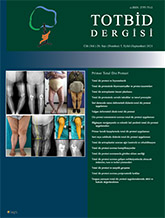
Total knee arthroplasty infections are one of the most difficult complications to treat after total knee arthroplasty which imposes serious burdens on the patient, physician and health system. Considering the difficulties related to the diagnosis and treatment of total knee arthroplasty infection, patient health and economic reasons, prevention of infection rather than treatment would be a more appropriate approach. Prevention should begin with the identification of the risk factors of the patient, and the existing risk factors should be optimized adequately and carefully in the preoperative period. The compliance of the operating room to the standards, meticulous surgery, avoidance of soft tissue damage and effective treatment of postoperative wound complications also play a significant role in preventing total knee arthroplasty infection. Once total knee arthroplasty infection occurs, the correct diagnosis should be made immediately and the most appropriate treatment method for the patient should be determined and applied. While determining the appropriate treatment approach; age, duration of symptoms, comorbidities, bone quality, soft tissue coverage and type of microorganism should be considered. In this review, risk factors for periprosthetic infection, prevention methods and treatment methods applied after infection is discussed based on current information.